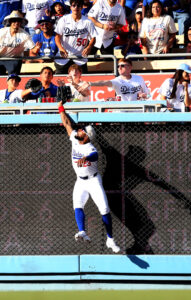There are multiple driving factors behind the Cubs’ disappointing 2024 season, but one of the most prominent flaws has been a catching corps that ranks near the bottom of the league in terms of offensive production. By measure of wRC+, only the last-place White Sox and Marlins have received lesser contributions than the Cubs’ collective .221/.265/.352 from their backstops.
The quartet of Yan Gomes, Miguel Amaya, Tomas Nido and Christian Bethancourt have accounted for all of the Cubs’ plate appearances at catcher this season. And while Amaya has turned things around of late — he’s hitting .358/.402/.589 over his past 105 plate appearances — adding some catching help remains a “priority” for the Cubs in the forthcoming offseason, Sahadev Sharma of The Athletic reports.
As Sharma explains at greater length, Amaya’s turnaround isn’t necessarily a small-sample fluke. He changed his setup in the batter’s box and ditched his leg kick for a toe-tap back in early July, and his results have taken off since. At the same time, it’s only 105 plate appearances (during which he has a .372 BABIP), and the Cubs understandably aren’t ready to put all their eggs in that one basket just yet.
Adding catching help is a natural goal for the Cubs, not only because of the 2024 group’s overall dearth of production but also because the lineup generally needs more offense but lacks clear areas for potential change. In the outfield, Ian Happ, Cody Bellinger, Seiya Suzuki and Pete Crow-Armstrong are locked into a rotation. It’s possible Bellinger triggers an opt-out in his contract at season’s end, but he’s no lock to do so when he’s hitting .269/.328/.423 on the season.
Around the infield, things are mostly set with deadline pickup Isaac Paredes at third base, Dansby Swanson at shortstop, Nico Hoerner at second and Michael Busch at first. The Cubs don’t have a set designated hitter, but with four outfielders all meriting regular playing time, one of that quartet can line up as the DH on any given day.
It’s at least possible the Cubs could look to shake up the current group on the offseason trade market, but their options there are limited. Swanson, Happ and Suzuki all have no-trade clauses. Paredes was only just acquired and isn’t going to be moved so quickly. Busch has had a productive rookie season and has five additional seasons of club control. Crow-Armstrong started slow at the plate but has picked up steam of late — and he’s an elite defender who’s gone 26-for-27 in stolen base attempts. Like Busch, he has five seasons of club control remaining.
The middle infield has been a letdown for the Cubs in terms of offensive production. Swanson hit .244/.328/.416 with 22 homers in his first season as a Cub last year but has dipped to .229/.303/.369 this season. He’s still playing exceptional defense, however, and as previously noted cannot be traded without his consent. (The remaining five years on his contract wouldn’t generate huge interest on the heels of a down season at the plate anyhow.) Hoerner’s name popped up on the rumor mill prior to this season’s deadline, with the Dodgers reportedly among the interested teams. He’s hitting .257/.326/.351 as of this writing. Like Swanson, it’s sub-par offense that’s paired with premium defense and baserunning. Hoerner is signed through 2026 and was an above-average hitter as recently as 2023.
All told, the Cubs’ lineup is largely set, with the exception of next year’s starting catcher. Amaya has another month to stake his claim to that role, but catcher is a natural spot for president of baseball ops Jed Hoyer to look to inject some life into his lineup. The Cubs reportedly pursued young Angels catcher Logan O’Hoppe prior to the deadline, so it’s hardly a surprise to see that they’re gearing up to look for upgrades this winter.
That said, the upcoming class of free agents doesn’t include a clear-cut answer. Danny Jansen is the top option on the open market, but after hitting .237/.317/.487 (121 wRC+ from 2021-23, he’s stumbled with a .214/.303/.363 slash this season (90 wRC+). Gary Sanchez, Elias Diaz and Carson Kelly are among the other options, but none is a clear candidate to serve as a meaningful upgrade.
The Cubs have a strong farm system and could use some of that prospect depth to pursue alternatives. Their interest in O’Hoppe suggests they’ve perhaps already laid the groundwork on some pursuits of this nature. There’s no indication the Angels are open to moving O’Hoppe, but the Cubs could revisit that scenario. There are other clubs with ample catching depth to spare. The Dodgers have Will Smith signed for another decade but prospects Dalton Rushing and Diego Cartaya behind him (though the latter hasn’t hit well in Triple-A and has seen his stock drop considerably). The Mariners have Cal Raleigh locked in at catcher, but 2021 first-rounder and top prospect Harry Ford isn’t far from MLB readiness. Perhaps the A’s would be open to moving Shea Langeliers and his 22 home runs as he gets another step closer to arbitration.
That’s a speculative list of options, to be clear, but the underlying point remains clear. The Cubs have a need to improve the lineup but little flexibility as they strive to do so, with catcher the most straightforward option. But while that’s a straightforward need, the path to achieve it is obscured by a lack of impactful free agents and clear impact trade candidates at a generally thin position.
